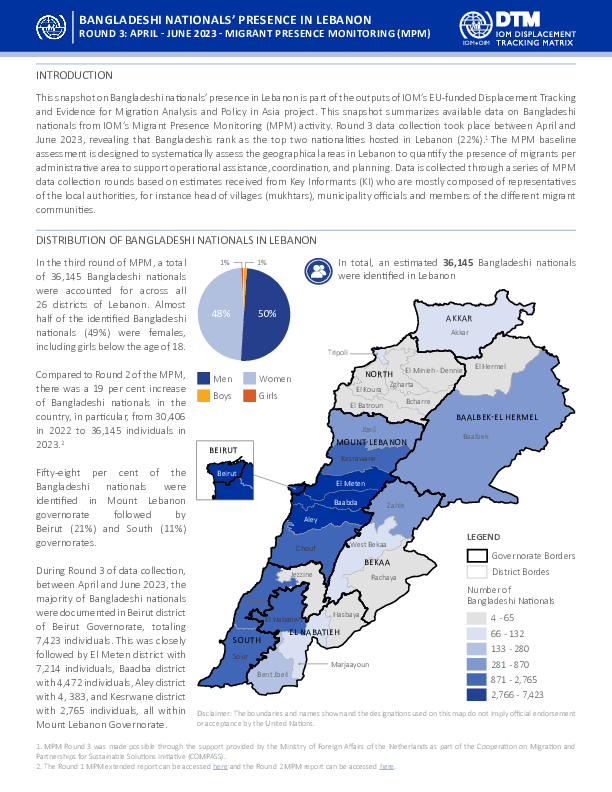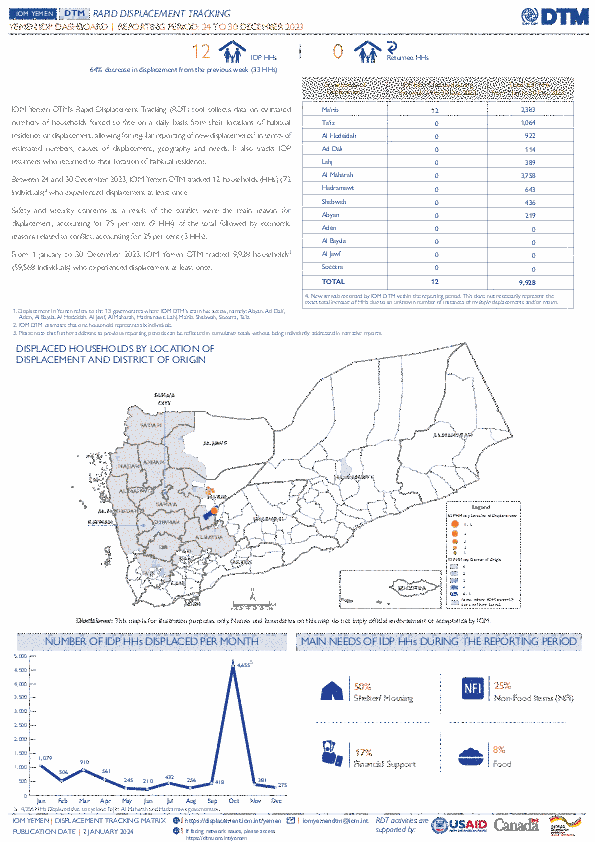-
Countries
-
Data and Analysis
-
Special Focus
-
Crisis Responses

Contact
DTM Somalia, IOMSomaliaDTM@iom.int
Language
English
Location
Somalia
Period Covered
Dec 10 2023
Dec 23 2023
Activity
- Mobility Tracking
- Event Tracking
In response to the Somalia’s severe drought beginning in November 2021, DTM Somalia launched an Emergency Trends Tracking (ETT) tool first in Gedo and Bay regions in 2022, and subsequently in Hiraan, Banadir and Middle Shabelle regions in 2023 to monitor drought related displacement trends and hotspots in support of operational planning. However, during the first half of 2023, conflict and flooding displacements have been significant. Therefore, DTM restructured its ETT tool to capture multi-shock displacements (drought, flood, conflict and other) from October 2023. In December 2023, ETT coverage has been expanded to Afgoyee district in Lower Shabelle region to cover the migration corridor between Afgooye and Mogadishu towns. As well as this, from week 49 onwards, ETT activities in Banadir have been paused.
ETT is a crisis-based tool that tracks sudden displacement triggered by specific events or emerging crises. The objective of ETT is to help prioritize humanitarian response and to enable partners to deliver rapid assistance.

Contact
DTM REMAP Support Team (dtmremapsupport@iom.int); DTM REMAP Bangladesh Team (remapbd@iom.int)
Language
English
Location
Bangladesh
Period Covered
Apr 01 2023
Jun 30 2023
Activity
- Mobility Tracking
- Baseline Assessment
This snapshot summarizes available data on Bangladeshi nationals in Lebanon from IOM’s Migrant Presence Monitoring (MPM) Round 3. Round 3 data collection took place between April and June 2023. The MPM baseline assessment is designed to systematically assess the geographical areas in Lebanon to quantify the presence of migrants per administrative area to support operational assistance, coordination, and planning. Data is collected through a series of MPM data collection rounds based on estimates received from Key Informants (KI) who are mostly composed of representatives of the local authorities, for instance head of villages, municipality officials and members of the different migrant communities. Round 2 data collection took place between May and July 2022 and Round 1 data collection took place between October 2020 and June 2021. The previous snapshots can be accessed here: Round 1, Round 2.
Contact
DTM Yemen, iomyemendtm@iom.int
Location
Yemen
Activity
- Mobility Tracking
- Event Tracking
Period Covered
Dec 24 2023 -Dec 30 2023
From 1 January to 30 December 2023, IOM Yemen DTM tracked 9,928 households (HH) (59,568 Individuals) who experienced displacement at least once.
Between 24 and 30 December 2023, IOM Yemen DTM tracked 12 households (72 individuals) displaced at least once. The majority of people moved into/within the following governorates and districts:
- Ma’rib (21 HHs) – Marib (9 HHs), Marib City (7 HHs), Harib (5 HHs) districts. Most displacements in the governorate originated from Marib and Taiz.
- Al Hodeidah (9 HHs) – Al Khukhah (9 HHs) district. Most displacements in the governorate originated from Al Hodeidah and Taiz.
- Ta’iz (2 HHs) – Al Mudhaffar (2 HHs) district. All displacements in the governorate were internal.
The majority of people moved from the following governorates and districts:
- Ma’rib (10 HHs) – Harib (6 HHs), Raghwan (2 HHs), Bidbadah (1 HH) districts.
- Al Hodeidah (8 HHs) – At Tuhayta (7 HHs), Al Marawiah (1 HH) districts.
- Ta’iz (6 HHs) – Maqbanah (3 HHs), Salah (1 HH), Sharab As Salam (1 HH) districts.
Population Groups
Survey Methodology
Unit of Analysis Or Observation
Type of Survey or Assessment
Keywords
Geographical Scope
Administrative boundaries with available data
The current dataset covers the following administrative boundaries

Contact
DTM Yemen, iomyemendtm@iom.int
Language
English
Location
Yemen
Period Covered
Dec 24 2023
Dec 30 2023
Activity
- Mobility Tracking
- Event Tracking
IOM Yemen DTM’s Rapid Displacement Tracking (RDT) tool collects data on estimated numbers of households forced to flee on a daily basis from their locations of origin or displacement, allowing for regular reporting of new displacements in terms of estimated numbers, geography, and needs. It also tracks returnees who returned to their location of origin.
From 1 January to 30 December 2023, IOM Yemen DTM tracked 9,928 households (HH) (59,568 Individuals) who experienced displacement at least once.
Between 24 and 30 December 2023, IOM Yemen DTM tracked 12 households (72 individuals) displaced at least once. The majority of people moved into/within the following governorates and districts:
- Ma’rib (21 HHs) – Marib (9 HHs), Marib City (7 HHs), Harib (5 HHs) districts. Most displacements in the governorate originated from Marib and Taiz.
- Al Hodeidah (9 HHs) – Al Khukhah (9 HHs) district. Most displacements in the governorate originated from Al Hodeidah and Taiz.
- Ta’iz (2 HHs) – Al Mudhaffar (2 HHs) district. All displacements in the governorate were internal.
The majority of people moved from the following governorates and districts:
- Ma’rib (10 HHs) – Harib (6 HHs), Raghwan (2 HHs), Bidbadah (1 HH) districts.
- Al Hodeidah (8 HHs) – At Tuhayta (7 HHs), Al Marawiah (1 HH) districts.
- Ta’iz (6 HHs) – Maqbanah (3 HHs), Salah (1 HH), Sharab As Salam (1 HH) districts.
IOM identified 20 households displaced in the previous reporting period, which covered 17 - 23 December 2023, in the governorates of . These figures have been added to the cumulative displacement total recorded since the beginning of the year.
Contact
dtmuganda@iom.int vwabwire@iom.in
Location
Uganda
Activity
- Mobility Tracking
- Baseline Assessment
Period Covered
Nov 01 2023 -Nov 30 2023
The ongoing heavy rains in the nation triggered extreme weather events which include floods and heavy storms in the month of November.
- The disasters affected a total of 38,547 individuals, representing 7,854 households while 15,962 individuals from 2,839 households were internally displaced.
- Adults (19-64 years) were the most affected population group (50%), followed by children under 18 years (42%) and the elderly who were above 64 years (8%).
- The most pressing needs are food assistance, NFI, Hygiene promotion among others.
- Houses partially damaged totaled 4,019 while 1,594 houses were completely destroyed. 208 water facilities, 42 health facilities and 32 schools were also affected.
- Disasters have so far affected 215,299 individuals and displaced over 47,467 people as reported from January to November 2023.
A more detailed version of this dataset is available, to get access kindly click on the 'Request Access' button
Population Groups
IDPs
Residents
Survey Methodology
Unit of Analysis Or Observation
Admin Area 2
Admin Area 3
Admin Area 4
Community
Type of Survey or Assessment
Key Informant
Keywords
Geographical Scope Full Coverage
Administrative boundaries with available data
The current dataset covers the following administrative boundaries
Contact
dtmlebanon@iom.int
Location
Lebanon
Activity
- Mobility Tracking
- Baseline Assessment
Period Covered
Oct 10 2023 -Dec 19 2023
Since October 8 there has been an increase in cross-border incidents between Israel and Lebanon, resulting in the displacement of people both within the South and elsewhere within the country. Since October 10, the Displacement Tracking Matrix (DTM) has been conducting the daily monitoring of population movements. The objective of the exercise is to inform preparedness and response planning.
A more detailed version of this dataset is available, to get access kindly click on the 'Request Access' button
Population Groups
IDPs
Survey Methodology
Unit of Analysis Or Observation
Admin Area 2
Admin Area 3
Household
Individual
Type of Survey or Assessment
Key Informant
Keywords
Geographical Scope Full Coverage
Administrative boundaries with available data
The current dataset covers the following administrative boundaries

Contact
DTM Sudan, DTMSudan@iom.int
Language
English
Location
Sudan
Period Covered
Nov 28 2023
Dec 27 2023
Activity
- Mobility Tracking
- Baseline Assessment
Overview
IOM DTM Sudan presents its fourth Monthly Displacement Overview. This publication provides an account of Sudan’s displacement context since 15 April 2023 – outlining population caseloads and movements, as well the present and evolving needs of Sudan’s growing IDP caseload.
Rationale
Recognizing the need for more detailed insights into the IDP situation, including the priority needs, access to services, movement intentions, and demographic breakdowns of the affected population, DTM Sudan has undertaken a comprehensive review of our data collection tool. In collaboration with a wide range of internal and external stakeholders, we have developed a new tool to better inform humanitarian response operations, aligning with the DTM global methodology. Leveraging our extensive network of approximately 360 field-based enumerators and a robust system of over 2,317 key informants across the country, DTM has gathered data on IDPs across 6,159 locations, in 171 of Sudan’s 189 localities – across all of Sudan’s 18 states.
Key Findings
- DTM Sudan estimates that 5,856,777 Individuals (1,165,764 Households) have been recently internally displaced.
- IOM DTM also reports that an estimated 1,523,350 mixed cross-border movements have been made into neighbouring countries.
- Since 15 April 2023, 45 per cent of the IDP caseload has sought refuge in the Darfur and Kordofan regions, whereas 55 per cent were observed across the Northern, Eastern, and Central states.
- The majority of the IDP caseload (65%) were seeking shelter with the host community.
- While food security remains the highest priority need, health and non-food items are also growing concerns.

Contact
DTMMozambique@iom.int
Language
English
Location
Mozambique
Period Covered
Dec 26 2023
Dec 28 2023
Activity
- Mobility Tracking
- Event Tracking
Between 26 - 28 December, attacks, and fear of attacks by Non-State Armed Groups in Macomia district (Mucojo and Pangane) triggered 434 individual displacements. Reported families have taken shelter across host communities in Macomia and Ibo districts. Assessment teams record 33 families/121 individuals displaced to Nanga A Host Community (Macomia) and 82 families/313 individuals displaced to Matemo Island (Ibo). Approximately 68 families/255 Individuals arriving on Matemo Island intend to proceed to Quirimbas Island within the next weeks.
Amongst recorded arrivals in Nanga A (Macomia), 53 are children under 18 years and 9 individuals have been identified with vulnerabilities. Amongst the recorded arrivals in Matemo Island (Ibo) 157 are children under 18 years and 3 individuals have been identified with vulnerabilities. Owing to prevailing security concerns reported by displaced families, intentions for the duration of their stay in host communities remains uncertain. Movements in the region continue to be dynamic within the district.
The objective of the Emergency Tracking Tool (ETT) - Movement Alert is to collect information on large and sudden population movements, and to provide support to the humanitarian response partners by disseminating data on IDPs to support effective humanitarian response to the affected population. Information is collected through key informants’ interviews or direct observation. This alert provides basic information on displacements, and additional information can be shared upon request.

Contact
DTM Europe, DTMMediterranean@iom.int
Language
Bosnian, Croatian, Serbian
Location
Bosnia & Herzegovina
Period Covered
Nov 01 2023
Nov 30 2023
Activity
- Flow Monitoring
Ovaj izvještaj pruža uvid u profile, iskustva, potrebe, rute putovanja i namjere migranata koji prolaze kroz Bosnu i Hercegovinu (BiH). Podaci su prikupljeni od 1. do 30. novembra 2023. IOM je proveo vježbu praćenja ruta u Republici Srpskoj, Kantonu Sarajevo, Posavskom kantonu, Tuzlanskom kantonu, Bosansko-podrinjskom kantonu i Unsko-sanskom kantonu kako bi pratio trendove ulazaka i izlazaka, te modalitete tranzita unutar BiH. IOM je anketirao 1.007 migranata na aktivnim tranzitnim lokacijama kao što su autobusne stanice i ključne ulazne i izlazne lokacije širom zemlje, kao i u četiri tranzitna prihvatna centra u BiH (Lipa, Ušivak, Borići i Blažuj).

Contact
DTM Europe, DTMMediterranean@iom.int
Language
English
Location
Bosnia & Herzegovina
Period Covered
Nov 01 2023
Nov 30 2023
Activity
- Flow Monitoring
This report provides insights into the profiles, experiences, needs, routes travelled and intentions of migrants transiting through Bosnia and
Herzegovina (BiH).1 Data was collected from 1 November to 30 November 2023.
IOM carried out a route observation exercise in the Republika Srpska, Sarajevo Canton, Posavina Canton, Tuzla Canton, Bosnian-Podrinje Canton and Una Sana Canton to monitor trends in entries and exits as well as transit modalities within BiH. IOM also surveyed 1,007 migrants in active transit locations such as bus stops or at key entry and exit locations throughout the country as well as in four transit reception centres in BiH (Lipa, Ušivak, Borići and Blažuj).
